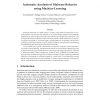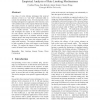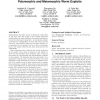19 search results - page 3 / 4 » Encounter-based worms: Analysis and Defense |
JCS
2011
12 years 10 months ago
2011
Malicious software—so called malware—poses a major threat to the security of computer systems. The amount and diversity of its variants render classic security defenses ineffe...
INFOCOM
2003
IEEE
14 years 22 days ago
2003
IEEE
— It has been clear since 1988 that self-propagating code can quickly spread across a network by exploiting homogeneous security vulnerabilities. However, the last few years have...
PADS
2005
ACM
14 years 1 months ago
2005
ACM
This study presents an analysis of the impact of mitigation on computer worm propagation in Mobile Ad-hoc Networks (MANETS). According to the recent DARPA BAA Defense Against Cybe...
RAID
2005
Springer
14 years 28 days ago
2005
Springer
One class of worm defense techniques that received attention of late is to “rate limit” outbound traffic to contain fast spreading worms. Several proposals of rate limiting t...
CCS
2005
ACM
14 years 1 months ago
2005
ACM
Vulnerabilities that allow worms to hijack the control flow of each host that they spread to are typically discovered months before the worm outbreak, but are also typically disc...



